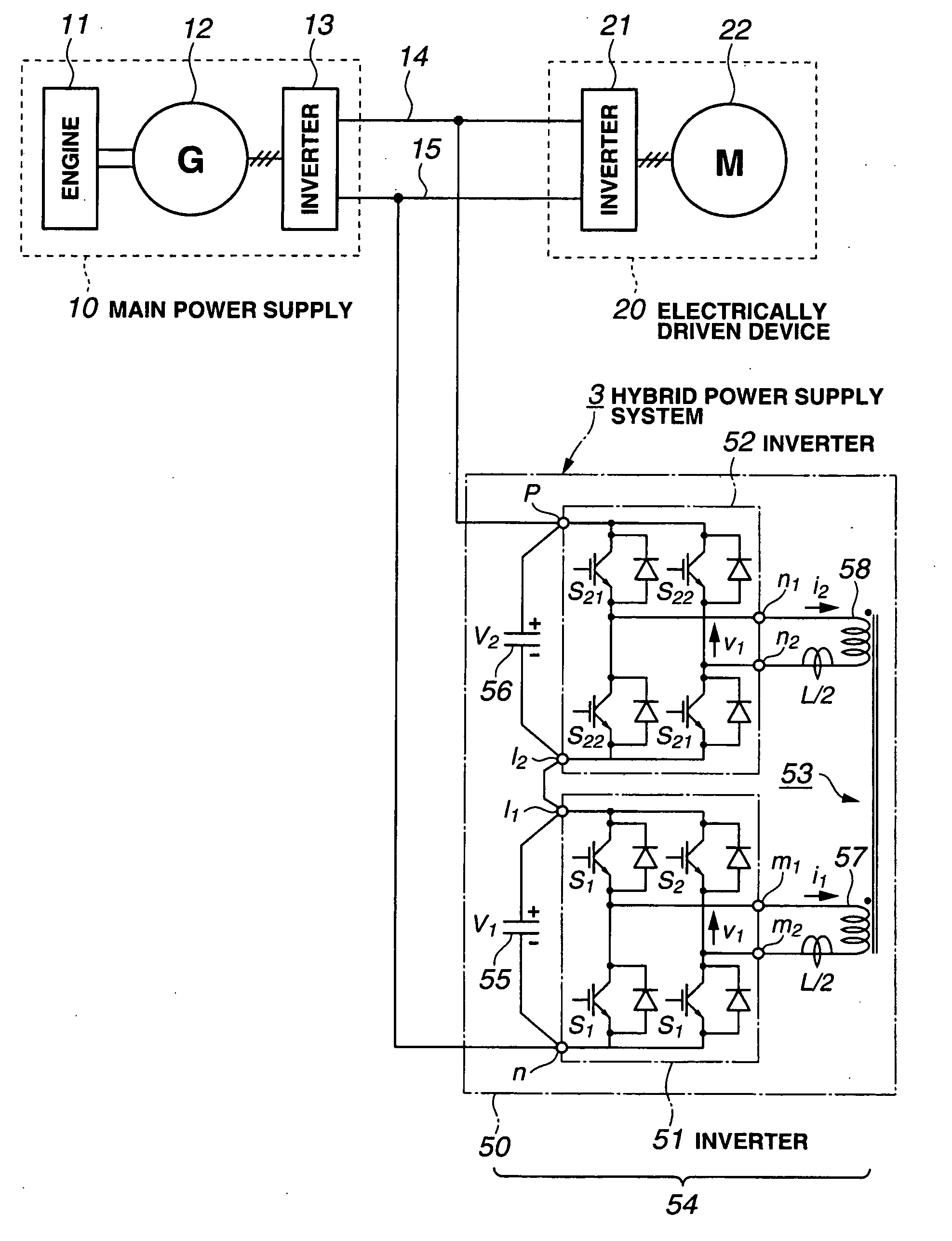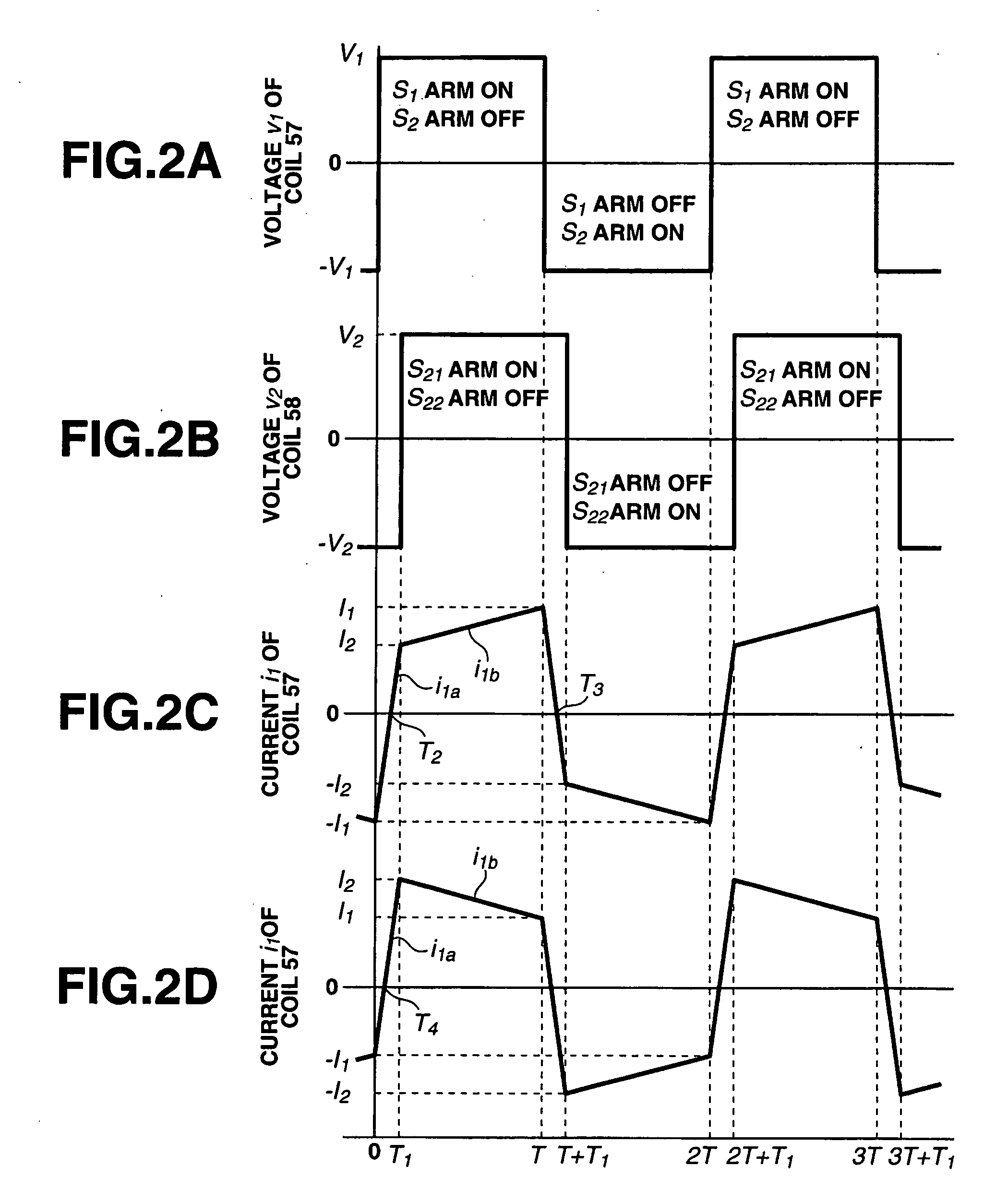AC Link Bidirectional DC-DC Converter, Hybrid Power Supply System Using the Same and Hybrid Vehicle
a hybrid power supply system and converter technology, applied in the direction of batteries/cells, process and machine control, instruments, etc., can solve the problems of high electric power loss, deterioration of electric power conversion efficiency, and high power loss of the power supply system b>1, so as to reduce the size and weight of the transformer 53, reduce the current rating of the semiconductor switching element used in the inverter, and reduce the voltage rating of the semiconductor switching elemen
- Summary
- Abstract
- Description
- Claims
- Application Information
AI Technical Summary
Benefits of technology
Problems solved by technology
Method used
Image
Examples
embodiment 1
[0079]FIG. 1 is a diagram for explaining a hybrid power supply system employing an AC link bidirectional DC-DC converter according to the present invention.
[0080]As shown in FIG. 1, a hybrid power supply system 3 is composed of a main power supply 10 and an auxiliary power supply 50.
[0081]The main power supply 10 is connected to the auxiliary power supply 50 through a positive line 14 and a negative line 15.
[0082]The auxiliary power supply 50 is composed of an AC link bidirectional DC-DC converter 54 and a capacitor 55 (voltage V1) functioning as an energy accumulation device. The AC link bidirectional DC-DC converter 54 is composed of an inverter 51, an inverter 52, and a transformer 53. A condenser or the like may be used as an energy accumulation device in place of the capacitor 55.
[0083]The inverter 51 comprises four semiconductor switching elements S1, S1, S2, S2. The semiconductor switching elements are each formed by an IGBT and an antiparallel diode. The semiconductor switch...
embodiment 2
[0161]FIG. 8 is a diagram showing an AC link bidirectional DC-DC converter in which two inverters are each formed by a half-bridge circuit. In FIG. 8, components designated with the same reference symbols as in FIG. 1 have same or similar functions as those in FIG. 1. For the convenience of description, the following description will be made in terms of an embodiment in which the AC link bidirectional DC-DC converter is incorporated in a hybrid power supply system.
[0162]As shown in FIG. 8, an AC link bidirectional DC-DC converter 64 is formed by an inverter 51 comprising semiconductor switching elements S1, S2 and an inverter 52 comprising semiconductor switching elements S21, S22.
[0163]In the AC link bidirectional DC-DC converter 64, a positive DC terminal I1 of the inverter 51 is connected in series to a negative DC terminal I2 of the inverter 52 in additive polarity. The inverter 51 is connected in parallel to a serially-connected pair of capacitors 55a and 55b while polarities t...
embodiment 3
[0167]FIG. 9 is a diagram showing an AC link bidirectional DC-DC converter in which two inverters are formed by multiphase bridge connection. The following description will be made in terms of a three-phase bridge connection. Since the connection to the capacitor 55 and the main power supply 10 in this embodiment is basically same as that of Embodiment 1, the following description will be made only on different points from Embodiment 1.
[0168]In FIG. 9, the AC link bidirectional DC-DC converter 74 is formed by an inverter 51 comprising semiconductor switching elements S1, S2, S3, S4, S5, S6 and an inverter 52 comprising semiconductor switching elements S21, S22, S23, S24, S25, S26.
[0169]The inverter 51 has three pairs of semiconductor switching elements (S1, S2), (S3, S4), (S5, S6). Each pair of semiconductor switching elements is connected in series to each other and the three pairs are connected in parallel to each other. The inverter 52 has three pairs of semiconductor switching e...
PUM
 Login to View More
Login to View More Abstract
Description
Claims
Application Information
 Login to View More
Login to View More - R&D
- Intellectual Property
- Life Sciences
- Materials
- Tech Scout
- Unparalleled Data Quality
- Higher Quality Content
- 60% Fewer Hallucinations
Browse by: Latest US Patents, China's latest patents, Technical Efficacy Thesaurus, Application Domain, Technology Topic, Popular Technical Reports.
© 2025 PatSnap. All rights reserved.Legal|Privacy policy|Modern Slavery Act Transparency Statement|Sitemap|About US| Contact US: help@patsnap.com



